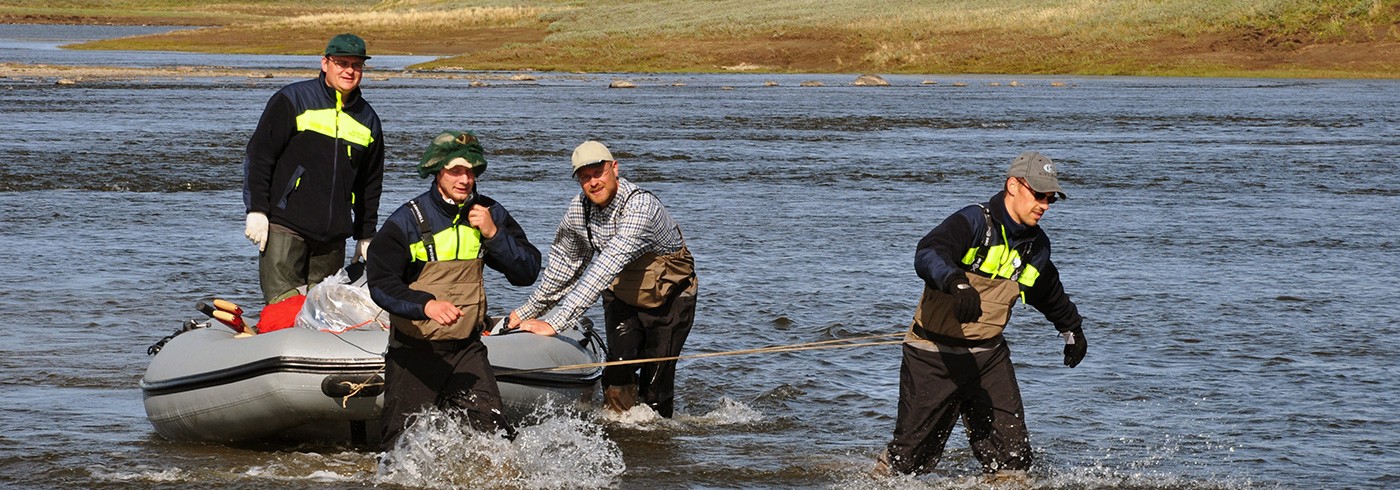
After a 200 km long Mi8 helicopter flight we are out on the seemingly endless and beautiful tundra. Photo: Per Möller
After a 200 km long Mi8 helicopter flight yesterday from the north Siberian village Khatanga – a village at the border between taiga and tundra, i.e. when the more or less dense larch forest finally disappears – we are out on the seemingly endless and beautiful tundra.

For the coming five weeks we intend to travel down the Bolshaya Balakhnya in our three zodiacs. Photo: Per Möller
Khatanga is a village totally without road connection; the life-line is a weekly flight from Norilsk, and cargo shipped in during the summer from the Arctic Sea. Khatanga is a story of its own; once during Soviet times it was a village of some 12 000 inhabitants, but the population is now down to a few thousands and the village seems to weather from inside. No improvements can be seen since I visited it the first time in 1996.
The larger part of the first expedition week was spent on the gradual approach towards Khatanga, and then two hectic days to control and pack the pre-sent expedition equipment. And buying food! The latter is a special treat in Khatanga, having absolutely no supermarket, but a large number of free enterprise small shops. Owners are a bit surprised when we ask for 180 cans of crushed tomatoes and we empty them on the 40 cans they have. And buying 20 kg of salami when the whole stock is 1.5 kg means a lot of running around. This in a Khatanga blazing under the sun with an amazing temperature of 27 °C and the mosquitos swarming black around your head.

Measurement of bone. The primary goal for the biologists is to study animal evolution and extinctions. Photo: Per Möller
We are now, thankfully, camped in our first base camp in the upper reaches of the Bolshaya Balakhnya River, a river on southern Taymyr. The Taymyr Peninsula is a vast area, stretching between 70 to 74 degrees north, and is large as half of Sweden. We mean my fellow geologists Ivar Örn Bennetiksson from Reykjavik University, Dima Bolsheyanov and Grischa Federov from the Arctic and Antarctic Research Institute (AARI) in St. Petersburg, and the biologists Love Dahlén from the Swedish Natural History Museum and Kenneth Andersen from Copenhagen University. And then myself, Per Möller, leader of the expedition and a professor in Quaternary geology from Lund University.
For the coming five weeks we intend to travel down the Bolshaya Balakhnya in our three zodiacs, c. 200 km, putting up successive base camps from which we will ravel up- and down river in our search for, and work with, geological sections cut by the river along its sides. From these sections we hopefully will get an insight in the environmental history of this area over the last c. 200 000 years with build-ups and down-wastings of ice sheets, and intervening periods of deeps seas and dry land as a result of the thickness of former ice sheets, pressing down the land surface beneath it, the latter rising gradually after the ice sheet is gone. The primary goal for the biologists is to study animal evolution and extinctions, based on DNA that will be extracted from bone remains and DNA directly preserved in the sediments of our geological sections.

We are now camped in our first base camp in the upper reaches of the Bolshaya Balakhnya River, a river on southern Taymyr. Photo: Per Möller
This has been our first day doing field work. We have been travelling upstream for some 11 km beneath a deep blue sky, lined with nice cumulus clouds and a nice temperature at 17 °C. The tundra along the river banks is in its fullest bloom and the river is plentiful with gees and ducks, especially the beautiful red-breasted goose. At lunch we could study the den of a polar fox family, five cubs coming out from their underground tunnels when one of the parents came running home with its mouth full of lemmings.
Scientifically, the highlight of the day was a section with alternating sand and peat layers, hosting bone remnants from mammoth, horse, bison, muskox and reindeer. From previous experiences of similar sediments from the shores of the large Taymyr Lake, situated a few tens of kilometres to the north, a qualified guess is that these bone remnants are from wildlife roaming what we call the “mammoth step”, present here some 20–25 thousands of years ago, at the same time at which Scandinavia was covered by thick inland ice.
When this is written the midnight sun stands high in the north, and one of my collegues fries fresh fish from the river for tomorrows lunch package.
Per Möller, Lunds universitet







